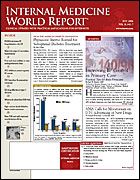Interatrial Block: The Unappreciated Pandemic?
Dr Spodick is Professor of Medicine, Department of Cardiology, University of Massachusetts Medical School, Worcester, Mass
The P wave is the electrocardiogram’s (ECG’s) neglected deflection. Although both the supraventricular and ventricular morphologic changes of arrhythmias are certainly recognized, normal and abnormal P-wave morphologies during sinus rhythm are quite often overlooked and are usually given short shrift in textbooks.
Probably the best example is interatrial or intraatrial block (Table). If the standards of the World Health Organization and the textbooks are correct, the maximum duration of a normal P wave is 100 ms. Since excess time on an ECG is a block (here, >100 ms), a P wave exceeding 100 ms would imply intraatrial or interatrial block (Figure), the latter being much more likely, since such P waves frequently have 2 peaks, 1 for each atrium, implying a delay in the conducting tissues between the atria, mainly the Bachmann bundle (interatrial bundle).
The resulting P wave, which resembles a low-amplitude “P mitrale,” was experimentally produced by Sunao Tawara in the early 20th century by crushing the Bachmann bundle. Recent work has repeatedly shown, at least in the hospital inpatient and outpatient populations, that interatrial block is surprisingly prevalent.
By accepted definitions, interatrial block would begin at 110 ms. However, trying to be more specific, investigators used 120 ms as the “beginning” of interatrial block in studies including a total of 2500 patients who were seen at 3 large university-affiliated hospitals in 2 different cities. The results demonstrated that >40% of inpatients and almost the same proportion of outpatients had interatrial block. In addition, prevalence rose to >60% among those aged ≥60 years. (In these studies, 110 ms was omitted to improve precision, since on ECG, 10 ms is only 1 mm.)
The main importance of interatrial block is in its ability to predict the risk of atrial fibrillation, atrial flutter, and other atrial arrhythmias. It may be the dominant P wave when such arrhythmias are paroxysmal (ie, the dominant P wave between arrhythmic attacks). Interatrial block also appears to be common in patients with embolic stroke.
Doppler studies have shown that the wide P waves of an interatrial block are associated with significantly delayed filling of the left, but not the right, atrium—exactly as would be expected with an interatrial conduction delay. Interatrial block also delays contraction of the coronary sinus, the walls of which are constructed mainly of left atrial (LA) muscle.
Furthermore, there is a strong correlation between interatrial block and abnormal P-terminal force (Ptf)—a biphasic P wave in lead V1 that is a sign of LA enlargement. (Ptf is the negative phase of P-V1; in LA enlargement, it encloses an area comprising ≥1 small box of the electrocardiographic grid [40 ms x 0.1 mV]). This is also not surprising, since echocardiographic volumetric investigations have found that in interatrial block, the LA is large, baggy, and hypocontractile.
LA “strength,” as represented by LA kinetic energy (LAKE), progressively worsens as the interatrial conduction time increases (over a range of interatrial block from 120 to >200 ms), with an inverse linear correlation to LAKE. With a definitely split P wave (which is usually the case; relatively few are not clearly split) in interatrial block, an interpeak distance of ≥40 ms is an extremely specific sign of LA enlargement.
One of the reasons interatrial block is frequently missed is the traditional reliance on lead II, which dates from the 1920s, when there were only 3 leads. Lead II by no means shows all examples of interatrial block. As with all ECG intervals (eg, QRS and QT), the lead or leads with the longest duration shows the appropriate conduction time.
Finally, a caveat is applicable to several of these studies: even though there was a wide range of P-wave duration, by far, the mode P-wave duration was 120 ms, implying that perhaps the standard for “normal” should be reevaluated, especially in older patients. As with the widening seen in LA, and especially left ventricular, disease, the P wave may also widen with normal aging; at some P-wave duration there may be a definite transition to interatrial block. Unfortunately, like many of our electrocardiographic standards, there has been no modern epidemiologic reevaluation of P-wave duration.
P-wave duration also correlates with M-mode LA diameter, as could be expected, but 2- (and 3-)dimensional volumetric calculation is far more productive.
Physicians should become more familiar with the apparent frequency and implications of interatrial block, textbooks should be improved, and interatrial block should be further investigated.
